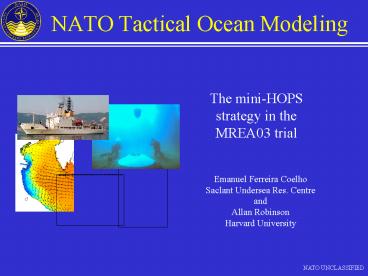NATO Tactical Ocean Modeling - PowerPoint PPT Presentation
Title:
NATO Tactical Ocean Modeling
Description:
Though Inertial Motion is one of the most frequent Ocean ... REAL-Time Modeling Data Flow. Courtesy of Reiner Onken. Grid Setup. Initial/Boundary Conditions ... – PowerPoint PPT presentation
Number of Views:35
Avg rating:3.0/5.0
Title: NATO Tactical Ocean Modeling
1
NATO Tactical Ocean Modeling
The mini-HOPS strategy in the MREA03 trial
Emanuel Ferreira Coelho Saclant Undersea Res.
Centre and Allan Robinson Harvard University
2
Motivation
Advection
Local Acceleration
Coriolis Acceleration
- Any time changing dynamical phenomena can trigger
Inertial Motion - Though Inertial Motion is one of the most
frequent Ocean phenomena, it is not easily
included into NATO available operational
forecasting systems
3
Motivation
Advection
Local Acceleration
Coriolis Acceleration
- Once Inertial Motion is established it can go
through interactions with the surrounding medium - Topography generating coastal trapped
waves - Stratification generating high frequency
Internal Waves - Underlying flow generating distorted
patterns and near-inertial Internal Waves
4
OCEAN MODELING SURVEY7-17 MAY 2002
ASCOT 02 (SLC-HARV Univ)
- Satellite, ship and mooring data
- collection
- AUV Environmental Missions
- Real-time data processing
- Real-time modeling with
- water column data assimilation
5
ASCOT02(sub) mesoscale example
OBSERVED FIELD DATA
REAL TIME MODELING FIELDS
25m depth
5m depth
Modeling fields from Harvard University Ocean
Prediction System and Reiner Onken (SLC)
6
REAL-Time Modeling Data Flow Courtesy of Reiner
Onken
Internet Server
Navy Commands
Model Results
Bathymetry
Data Bases
Climatology
Weather Service
Meteorology
Survey Platforms
Real-Time Data
Forcing Fields
AssimilationFields
Grid Setup
Initial/Boundary Conditions (MODAS/POM, other)
Forecast
Data Sources
Server Data
HOPS
Customer
7
High variability observed at the surface
fields(3 hours time steps
Modeling fields from Harvard University Ocean
Prediction System and Reiner Onken (SLC)
8
ISSUES TO BE CONSIDERED
1 For operational usage what water velocity
estimates should be considered? (direct model
outputs or averages?) 2 What is the uncertainty
of these field estimates?
Need to define a strategy to use operational and
real-time modeling in the presence of high
frequency phenomena option 1 to be tested
separate high frequency variability from the
lower frequency and use it as an incremental
parameter for uncertainty estimation Option 2 to
be tested obtain high frequency data and nest
small domains running real-time modeling for
local uncertainty reduction (mini-HOPS strategy)
9
Strong Near-Inertial Motion Observed
B1
B2
B1
B2
10
HOPS velocity estimates with large relative RMS
deviations
B1
B2
B1
B2
(mostly due to observed high frequency
variability)
11
HOPS system is not reducing the uncertainty of
local instantaneous surface velocity estimates
(when compared to simple model estimates using
shipborn observed winds)
B1
B2
B1
B2
12
Though the HOPS is not reducing uncertainty is
capturing better the observed dominant
sub-inertial to inertial energy of local
instantaneous surface velocity estimates
B1
B2
Observed Time Evolution of Surface Spectral
Estimates
HOPS Time Evolution of Surface Spectral Estimates
B1
Simple model
B2
13
Though the HOPS is showing large RMS deviations
is capturing most of the observed profile
dominant sub-inertial to inertial energy
B1
HOPS Time Evolution of Spectral Estimates
Observed Time Evolution of Spectral Estimates
14
Though the HOPS is showing large RMS deviations
is capturing most of the observed profile
dominant sub-inertial to inertial energy
B2
HOPS Time Evolution of Spectral Estimates
Observed Time Evolution of Spectral Estimates
15
Discussion
- The North Elba region showed very strong
inertial and sub-inertial dynamics - The observed dynamics suggests strong internal
wave and other sub-inertial phenomena being
interacted and forced by inertial motion - Inertial motion solution is impossible to obtain
in a full regional domain (too expensive), but
local data can be used to monitor local
near-inertial dynamics - Though the HOPS was not able to reduce local
uncertainty, due to high inertial and
sub-inertial variability, it contained the
observed physics (attenuated and phase lagged).
16
Proposed solution Mini-HOPS concept
- Real-time modeling as been tested and widely
demonstrated - Major advantage can improve local consistency
- Major disadvantage requires local data
gathering - Several global operational models are now
becoming available (NCOM, FOAM, MERCATOR, etc) - Major advantage fast and easy access
- Major disadvantage can have high local
uncertainty
ltA.Bgt mini-HOPS
17
The Mini-HOPS in the MREA03 Trial
Goal
Local high resolution data collection
- start with an operational model run (NRL
MODAS/POM) - nest three 20x20Km 50 superimposed domains on a
regional HOPS domain - perform assimilation cycles within one inertial
period - provide and monitor hourly outputs for 24-48
hours forecasts
18
NTOMS
- This strategy is part of the NATO tactical ocean
modeling system being developed at SACLANTCEN
Partners, consisting on the following steps - Start with available operational ocean and
meteorological models output analysis - Use model available statistics, opportunity data,
multiple model outputs and high frequency
(sub-inertial structures) energy estimates to
estimate overall uncertainty - Decide if local uncertainty is satisfactory based
on envisaged model output usage (at tactical or
operator level) - If not, implement an hierarchical methodology
from statistical/parametric modeling up to the
mini-HOPS strategy (using DISCRETE and COVERT
observational methods)
19
NATO Tactical Ocean Modeling
The mini-HOPS strategy in the MREA03 trial
Emanuel Ferreira Coelho Saclant Undersea Res.
Centre and Allan Robinson Harvard University
20
MET MODEL COMPARISON
To realistically track inertial motion, accurate
meteorological forcing is essential
Courtesy of R.Signell































